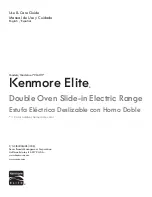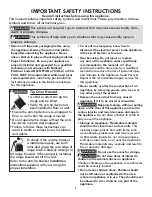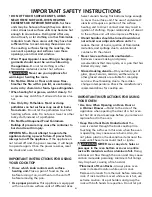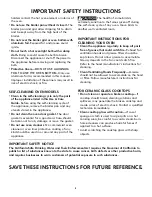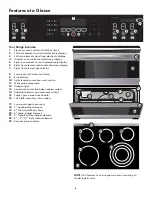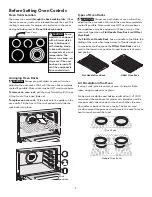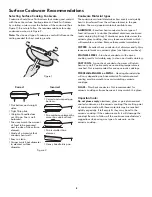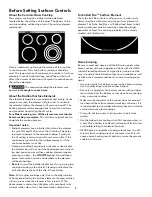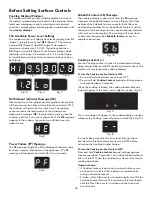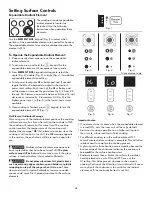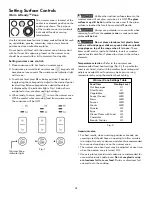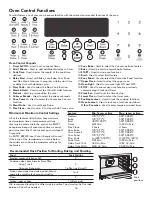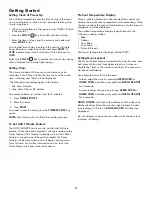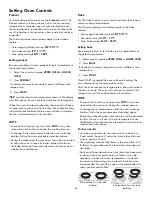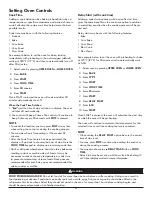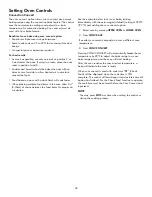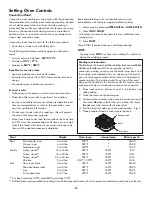
5
Important Safety InStructIonS
SaVe tHeSe InStructIonS for future reference.
holders contact the hot oven element or interior of
the oven.
•
Do not use the broiler pan without its insert.
The
broiler pan and grid allow dripping fat to drain
and be kept away from the high heat of the
broiler.
•
Do not cover the broiler grid or oven bottom with
aluminum foil.
Exposed fat and grease could
ignite.
•
Do not touch a hot oven light bulb with a damp
cloth.
Doing so could cause the bulb to break.
Disconnect the appliance or shut off the power to
the appliance before removing and replacing the
bulb.
•
Protective liners
—
DO NOT USE ALUMINUM
FOIL TO LINE THE OVEN BOTTOM.
Only use
aluminum foil as recommended in this manual.
Improper installation of these liners may result in
risk of electric shock, or fi re.
SeLf-cLeanInG oVen moDeLS
•
clean in the self-cleaning cycle only the parts
of the appliance listed in this use & care
Guide.
Before using the self-cleaning cycle of
the appliance, remove the broiler pan and any
utensils stored in the appliance.
•
Do not clean the oven door gasket.
The door
gasket is essential for a good seal. Care should
be taken not to rub, damage or move the gasket.
•
Do not use oven cleaners
. No commercial oven
cleaner or oven liner protective coating of any
kind should be used in or around any part of the
appliance
The health of some birds is
extremely sensitive to the fumes given off during
the self-clean cycle of any oven. Move birds to
another well ventilated room.
Important InStructIonS for
cLeanInG your oVen
•
Clean the appliance regularly to keep all parts
free of grease that could catch fi re.
Exhaust fan
ventilation hoods and grease fi lters should be
kept clean. Do not allow grease to accumulate.
Greasy deposits in the fan could catch fi re.
Refer to the hood manufacturer’s instructions for
cleaning.
•
clean Ventilating Hoods frequently
—Grease
should not be allowed to accumulate on the hood
or fi lter. Follow manufacturer’s instructions for
cleaning.
for ceramIc GLaSS cooKtopS
•
Do not clean or operate a broken cooktop
—If
cooktop should break, cleaning solutions and
spillovers may penetrate the broken cooktop and
create a risk of electric shock. Contact a qualifi ed
technician immediately.
•
Clean cooktop glass with caution
—If a wet
sponge or cloth is used to wipe spills on a hot
cooking area, be careful to avoid a steam burn.
Some cleaners can produce harmful fumes if
applied to a hot surface.
• Avoid scratching the cooktop glass with sharp
objects.
Important Safety notIce
the california Safe Drinking Water and toxic enforcement act requires the Governor of california to
publish a list of substances known to the state to cause cancer, birth defects or other productive harm,
and requires businesses to warn customers of potential exposure to such substances.
Important Safety InStructIonS
• Do not toucH Surface unItS, areaS
near tHeSe SurfaceS, oVen HeatInG
eLementS or InterIor SurfaceS.
Surface
units may be hot even though they are dark in
color. Areas near surface units may become hot
enough to cause burns. During and after use,
do not touch, or let clothing or other fl ammable
materials touch these areas until they have had
suffi cient time to cool. Among these areas are
the cooktop, surfaces facing the cooktop, the
oven vent openings and surfaces near these
openings, oven door and window.
•
Wear proper apparel. Loose-fi tting or hanging
garments should never be worn while using
the appliance.
Do not let clothing or other
fl ammable materials contact hot surfaces.
Never use your appliance for
warming or heating the room.
•
Do not use Water or flour on Grease fires.
Smother the fi re with a pan lid, or use baking
soda, a dry chemical or foam-type extinguisher.
•
When heating fat or grease, watch it closely.
Fat
or grease may catch fi re if allowed to become too
hot.
•
use only Dry potholders. moist or damp
potholders on hot surfaces may result in burns
from steam.
Do not let the potholders touch hot
heating surface units. Do not use a towel or other
bulky cloth instead of a potholder.
•
Do not Heat unopened food containers.
Buildup of pressure may cause the container to
burst and result in injury.
Important—Do not attempt to operate the
appliance during a power failure. If power fails,
always turn off the appliance.
If the appliance is
not turned off and the power resumes, it will begin
to operate again. Once the power resumes, reset
the clock and oven function.
Important InStructIonS for uSInG
your cooKtop
•
Know which knob controls each surface
heating unit.
Place a pan of food on the unit
before turning it on, and then turn the unit off
before removing the pan.
•
use proper pan size.
This appliance is equipped
with one or more surface units of diff erent sizes.
Select utensils having fl at bottoms large enough
to cover the surface unit. The use of undersized
utensils will expose a portion of the surface
heating unit to direct contact and may result in
ignition of clothing. Proper relationship of utensil
to the surface unit will also improve effi ciency.
•
utensil handles should be turned inward and
not extend over adjacent surface units.
To
reduce the risk of burns, ignition of fl ammable
materials, and spillage due to unintentional
contact with the utensil.
•
Never leave surface units unattended
—
Boilovers cause smoking and greasy
accumulations that may ignite, or a pan that has
boiled dry may melt.
•
Glazed cooking utensils
—Only certain types of
glass, glass/ceramic, ceramic, earthenware, or
other glazed utensils are suitable for rangetop
service without breaking due to the sudden
change in temperature. Check the manufacturer’s
recommendations for cooktop use.
Important InStructIonS for uSInG
your oVen
•
use care When opening an oven Door or
a Warmer Drawer
—Stand to the side of the
appliance when opening the door of a hot oven.
Let hot air or steam escape before you remove or
replace food in the oven.
•
Keep oven Vent Ducts unobstructed.
The oven is
vented at the at the center trim above the oven.
Touching the surfaces in this area when the oven
is operating may cause severe burns. Also, do
not place plastic or heat-sensitive items near the
oven vent. These items could melt or ignite.
neVer cover any slots, holes or
passages in the oven bottom or cover an entire
rack with materials such as aluminum foil.
Doing
so blocks air fl ow through the oven and may cause
carbon monoxide poisoning. Aluminum foil linings
may trap heat, causing a fi re hazard.
•
Placement of Oven Racks.
Always place oven
racks in desired location while oven is cool.
Remove all utensils from the rack before removing
rack. If rack must be moved while oven is hot, use
extreme caution. Use pot holders and grasp the
rack with both hands to reposition. Do not let pot

